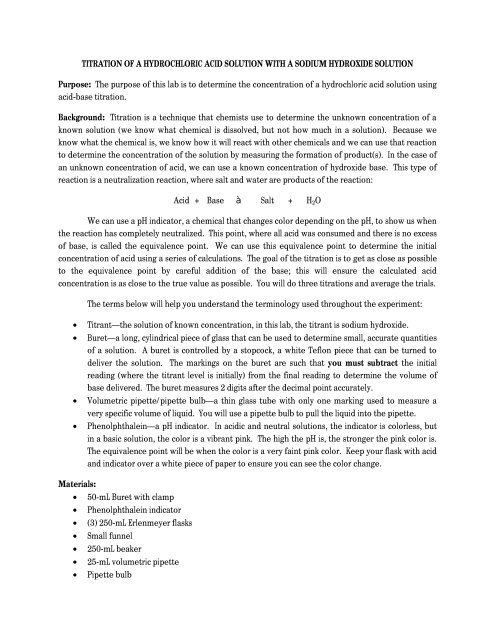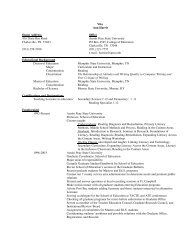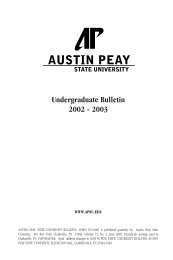Titration of an acid with a base lab
Titration of an acid with a base lab
Titration of an acid with a base lab
You also want an ePaper? Increase the reach of your titles
YUMPU automatically turns print PDFs into web optimized ePapers that Google loves.
TITRATION OF A HYDROCHLORIC ACID SOLUTION WITH A SODIUM HYDROXIDE SOLUTION<br />
Purpose: The purpose <strong>of</strong> this <strong>lab</strong> is to determine the concentration <strong>of</strong> a hydrochloric <strong>acid</strong> solution using<br />
<strong>acid</strong>-<strong>base</strong> titration.<br />
Background: <strong>Titration</strong> is a technique that chemists use to determine the unknown concentration <strong>of</strong> a<br />
known solution (we know what chemical is dissolved, but not how much in a solution). Because we<br />
know what the chemical is, we know how it will react <strong>with</strong> other chemicals <strong>an</strong>d we c<strong>an</strong> use that reaction<br />
to determine the concentration <strong>of</strong> the solution by measuring the formation <strong>of</strong> product(s). In the case <strong>of</strong><br />
<strong>an</strong> unknown concentration <strong>of</strong> <strong>acid</strong>, we c<strong>an</strong> use a known concentration <strong>of</strong> hydroxide <strong>base</strong>. This type <strong>of</strong><br />
reaction is a neutralization reaction, where salt <strong>an</strong>d water are products <strong>of</strong> the reaction:<br />
Acid + Base Salt + H 2 O<br />
We c<strong>an</strong> use a pH indicator, a chemical that ch<strong>an</strong>ges color depending on the pH, to show us when<br />
the reaction has completely neutralized. This point, where all <strong>acid</strong> was consumed <strong>an</strong>d there is no excess<br />
<strong>of</strong> <strong>base</strong>, is called the equivalence point. We c<strong>an</strong> use this equivalence point to determine the initial<br />
concentration <strong>of</strong> <strong>acid</strong> using a series <strong>of</strong> calculations. The goal <strong>of</strong> the titration is to get as close as possible<br />
to the equivalence point by careful addition <strong>of</strong> the <strong>base</strong>; this will ensure the calculated <strong>acid</strong><br />
concentration is as close to the true value as possible. You will do three titrations <strong>an</strong>d average the trials.<br />
The terms below will help you underst<strong>an</strong>d the terminology used throughout the experiment:<br />
• Titr<strong>an</strong>t—the solution <strong>of</strong> known concentration, in this <strong>lab</strong>, the titr<strong>an</strong>t is sodium hydroxide.<br />
• Buret—a long, cylindrical piece <strong>of</strong> glass that c<strong>an</strong> be used to determine small, accurate qu<strong>an</strong>tities<br />
<strong>of</strong> a solution. A buret is controlled by a stopcock, a white Teflon piece that c<strong>an</strong> be turned to<br />
deliver the solution. The markings on the buret are such that you must subtract the initial<br />
reading (where the titr<strong>an</strong>t level is initially) from the final reading to determine the volume <strong>of</strong><br />
<strong>base</strong> delivered. The buret measures 2 digits after the decimal point accurately.<br />
• Volumetric pipette/pipette bulb—a thin glass tube <strong>with</strong> only one marking used to measure a<br />
very specific volume <strong>of</strong> liquid. You will use a pipette bulb to pull the liquid into the pipette.<br />
• Phenolphthalein—a pH indicator. In <strong>acid</strong>ic <strong>an</strong>d neutral solutions, the indicator is colorless, but<br />
in a basic solution, the color is a vibr<strong>an</strong>t pink. The high the pH is, the stronger the pink color is.<br />
The equivalence point will be when the color is a very faint pink color. Keep your flask <strong>with</strong> <strong>acid</strong><br />
<strong>an</strong>d indicator over a white piece <strong>of</strong> paper to ensure you c<strong>an</strong> see the color ch<strong>an</strong>ge.<br />
Materials:<br />
• 50-mL Buret <strong>with</strong> clamp<br />
• Phenolphthalein indicator<br />
• (3) 250-mL Erlenmeyer flasks<br />
• Small funnel<br />
• 250-mL beaker<br />
• 25-mL volumetric pipette<br />
• Pipette bulb
Also <strong>of</strong> import<strong>an</strong>ce in titrations are the calculations you need to determine the unknown concentration<br />
<strong>of</strong> the <strong>acid</strong>. These calculations are outlined below. You may w<strong>an</strong>t to refer to your notes from lecture for<br />
additional examples.<br />
• Determination <strong>of</strong> moles <strong>of</strong> <strong>base</strong> delivered: After each titration, you will need to determine the<br />
number <strong>of</strong> moles <strong>of</strong> sodium hydroxide used. First, you will need to know the molarity <strong>of</strong> the<br />
solution (the solution has been previously st<strong>an</strong>dardized, me<strong>an</strong>ing it has a very accurate molarity<br />
that has been experimentally determined). Write this down when you start the titration. Next,<br />
you must determine the volume <strong>of</strong> the solution delivered to reach the equivalence point. Next,<br />
you will find the moles <strong>of</strong> <strong>base</strong> used in the titration:<br />
( ) × =<br />
*Note that the volume <strong>of</strong> <strong>base</strong> is in L, not in mL<br />
• Determine number <strong>of</strong> moles <strong>of</strong> HCl in flask: If you write the bal<strong>an</strong>ced reaction for the<br />
neutralization <strong>of</strong> sodium hydroxide <strong>an</strong>d hydrochloric <strong>acid</strong>, you will see that the reaction<br />
proceeds in a 1:1 fashion. That is, for every hydroxide (OH - ) ion added, it c<strong>an</strong> neutralize exactly<br />
one hydronium (H + ) ion. This is not always the case for neutralization reactions, <strong>an</strong>d is thus not<br />
always the case for <strong>acid</strong>-<strong>base</strong> titrations. The general formula is below, where the determined<br />
moles <strong>of</strong> <strong>base</strong> from the equation above are multiplied by the stoichiometric ratio found by<br />
looking at the bal<strong>an</strong>ced equation:<br />
( )<br />
× #<br />
=<br />
1 #<br />
• Determination <strong>of</strong> <strong>acid</strong> concentration: Now that you know the number <strong>of</strong> moles <strong>of</strong> <strong>acid</strong> in the<br />
flask (at the start <strong>of</strong> the titration, by the end, there is only water <strong>an</strong>d salt), you c<strong>an</strong> determine its<br />
initial concentration. Because you know the initial volume <strong>of</strong> <strong>acid</strong> used, you c<strong>an</strong> use the<br />
following to determine the concentration:<br />
= ( )<br />
Procedure: You will do three titrations. If you add too much <strong>base</strong> <strong>an</strong>d the solution is too bright pink,<br />
you will need to discard the data <strong>an</strong>d do <strong>an</strong>other run (4 columns <strong>of</strong> data are provided for this purpose).<br />
Patience in this <strong>lab</strong> will prevent you from having to do extra trials!!!<br />
1. Record the molarity <strong>of</strong> the sodium hydroxide solution on the data sheet<br />
2. Obtain about 100 mL <strong>of</strong> the sodium hydroxide solution in a cle<strong>an</strong> beaker. This should be enough<br />
for your first 3 trials <strong>an</strong>d for the initial cle<strong>an</strong>ing <strong>of</strong> your buret.<br />
3. Cle<strong>an</strong> your buret: Add about 5 mL <strong>of</strong> the <strong>base</strong> solution from the beaker to the buret (use a<br />
funnel to pour). Move the funnel around while adding to ensure the sides <strong>of</strong> the buret are<br />
coated <strong>with</strong> <strong>base</strong>. Drain the solution through the stopcock into a waste beaker. Repeat this<br />
rinse <strong>with</strong> a second 5 mL portion <strong>of</strong> <strong>base</strong>.<br />
4. Pour more <strong>of</strong> the sodium hydroxide solution into the buret until it is near the 50 mL mark. Open<br />
the stopcock to allow several drops to rinse through the tip <strong>of</strong> the buret. This will eliminate <strong>an</strong>y<br />
air bubbles in the buret tip. Record your initial buret reading on the data sheet for trial 1 (the<br />
volume does not need to be 0.00 mL).
5. Pull 25 mL <strong>of</strong> the <strong>acid</strong> solution into the volumetric pipette <strong>an</strong>d tr<strong>an</strong>sfer into <strong>an</strong> Erlenmeyer flask.<br />
Add 2-3 drops <strong>of</strong> phenolphthalein to the <strong>acid</strong> solution in the Erlenmeyer flask.<br />
6. Place the flask under the buret <strong>an</strong>d start adding the <strong>base</strong> solution to the Erlenmeyer flask. Have<br />
one <strong>lab</strong> partner swirl the flask while the other controls the stopcock. When pink starts to<br />
develop, add the solution more slowly. At this point you should add one drop at a time followed<br />
by swirling until a very light pink color persists. Remember, the lighter the pink the better!!!<br />
7. Record the final reading <strong>of</strong> the buret. Wash the contents <strong>of</strong> the flask down the drain <strong>with</strong> water.<br />
8. Refill the buret <strong>with</strong> more sodium hydroxide solution. Record the new volume under trial 2 on<br />
the data sheet. Get <strong>an</strong>other sample <strong>of</strong> <strong>acid</strong> <strong>an</strong>d add the phenolphthalein as before <strong>an</strong>d repeat<br />
the titration 2 more times.<br />
9. Fill in the data sheet <strong>an</strong>d post-<strong>lab</strong> questions. Show your work for full credit!!!
Name:_____________________________________<br />
TITRATION OF AN ACID WITH A BASE PRE-LAB<br />
*Show all <strong>of</strong> your work for full credit<br />
1. How will you know when your titration is finished?<br />
______________________________________________________________________________<br />
______________________________________________________________________________<br />
2. Label the pH scale below <strong>with</strong> <strong>acid</strong>, <strong>base</strong>, <strong>an</strong>d neutral, indicating numbers for each.<br />
3. On the scale above, use <strong>an</strong> arrow to show where your equivalence point is located.<br />
4. Show the neutralization reaction that occurs between hydrobromic <strong>acid</strong> (HBr) <strong>an</strong>d lithium<br />
hydroxide (LiOH).<br />
5. What is the concentration <strong>of</strong> 10.00 mL <strong>of</strong> HBr if it takes 5 mL <strong>of</strong> a 0.253 M LiOH solution to<br />
neutralize it?
TITRATION OF AN ACID WITH A BASE DATA SHEET<br />
*Attach all <strong>of</strong> your calculations for full credit<br />
Name:_________________________________<br />
Partner:________________________________<br />
Concentration <strong>of</strong> sodium hydroxide: __________________M<br />
Initial buret volume<br />
Final buret volume<br />
Volume <strong>of</strong> <strong>base</strong> (mL)<br />
Volume <strong>of</strong> <strong>base</strong> (L)<br />
Moles <strong>of</strong> <strong>base</strong><br />
Moles <strong>of</strong> <strong>acid</strong><br />
Trial 1 Trial 2 Trial 3 (Trial 4)<br />
Volume <strong>of</strong> <strong>acid</strong> 0.0250 L 0.0250 L 0.0250 L 0.0250 L<br />
Acid concentration<br />
Average<br />
concentration<br />
Questions:<br />
1. How would it affect your results if you used a beaker <strong>with</strong> residual water in it to measure out<br />
your st<strong>an</strong>dardized sodium hydroxide solution?<br />
______________________________________________________________________________<br />
______________________________________________________________________________<br />
______________________________________________________________________________
2. How would it affect your results if you used a wet Erlenmeyer flask instead <strong>of</strong> a dry one when<br />
tr<strong>an</strong>sferring your <strong>acid</strong> solution from the volumetric pipette?<br />
______________________________________________________________________________<br />
______________________________________________________________________________<br />
______________________________________________________________________________<br />
3. How do you tell if you have exceeded the equivalence point in your titration?<br />
______________________________________________________________________________<br />
______________________________________________________________________________<br />
4. Vinegar is a solution <strong>of</strong> acetic <strong>acid</strong> (CH 3 COOH) in water. For quality control purposes, it c<strong>an</strong> be<br />
titrated using sodium hydroxide to assure a specific % composition. If 25.00 mL <strong>of</strong> acetic <strong>acid</strong> is<br />
titrated <strong>with</strong> 9.08 mL <strong>of</strong> a st<strong>an</strong>dardized 2.293 M sodium hydroxide solution, what is the molarity<br />
<strong>of</strong> the vinegar? What is the % composition (wt/wt%)?<br />
Vinegar molarity: ____________________________<br />
Vinegar % composition: _______________________
















